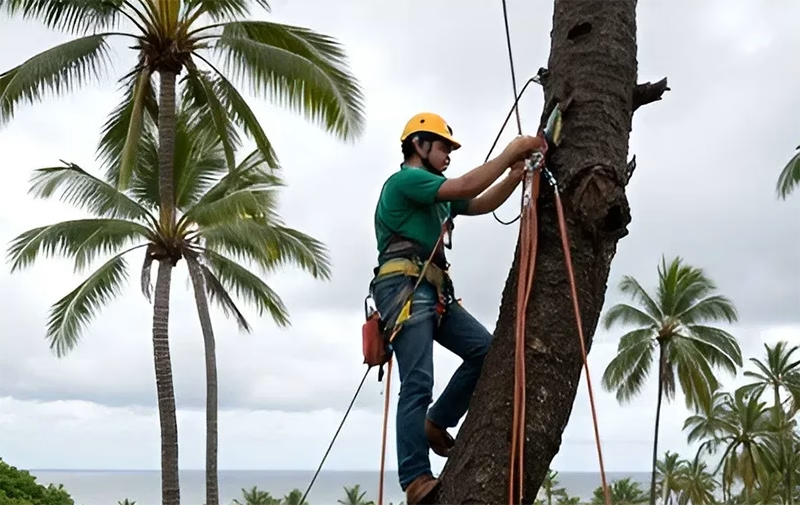When we think about real estate development in coastal areas, we often picture fancy things like luxury condos, beachside resorts, and million-dollar views. However, there are some factors that most people overlook. Behind all this lavishness, developers face a challenging reality: landscaping and tree removal—crucial factors that can determine whether a coastal development project succeeds or fails. In fact, if you ignore the landscape, nature won’t return the favor.
A lot of certified arborists who offer tree removal in Honolulu believe that landscaping and strategic tree removal are not just important—they are critical for successful, long-term real estate development in coastal climates. If you want to know the reasons behind this, read on.
Coastal Environments are Stunning—But Brutal
Coastal climates are undoubtedly very harsh. Salt-laden winds combined with sandy or unstable soil, high humidity, and extreme weather like hurricanes or tropical storms result in a disaster for any construction project.
You can build the most beautiful and elegant property, but if the surrounding land is not protected, it won’t last—it will fall apart. That is why landscaping plays a vital role. Planting salt-tolerant plants, deep-rooted covers, and carefully designing green zones can help in stabilizing the soil, preventing erosion, and reducing the impact of high winds and water runoff. Without them, your concrete foundation would stay, but everything around it could wash away.
Tree Removal Reduces Risk and Saves Money
Since dead or improperly placed trees can snap or fall and incur damage to buildings, vehicles, power lines, and worse—injure people—proactive tree removal, especially for older trees with shallow roots or poor health reduces these risks drastically.
Many developers skip tree assessments just to save time, neglecting that coastal storms don’t just bring wind—they bring danger. As a result, they end up spending much more later on storm-related repairs or legal liabilities. Remember that tree removal is not just about clearing every tree. It’s about knowing which ones pose a threat and removing them with intention.
Doing so can also improve access to sunlight and air circulation on your property, which is a very good bonus.
Landscaping is Your Property’s First Impression
We cannot deny that curb appeal really matters, especially in high-value coastal real estate. The property value and how fast it can be sold depend on its looks from the outside. But buyers are not just paying for square footage; they are buying the coastal living.
Smart landscaping adds thousands to a property’s perceived value. It makes a property not just beautiful; it makes homes feel cared for and investments feel solid. On the other hand, overgrown brushes, dead trees, or chaotic planting bring the opposite —and that’s where proper tree management and proper landscaping make the difference.
The Silent Enemy: Soil Erosion
After the coastal storms, the next challenge that you need to address is soil erosion. Heavy rains, rising tides, and loose sand make it easy for topsoil to wash away. That is why soil erosion is one of the biggest threats in coastal construction. If left unmanaged, it can lead to sinkholes, cracked foundations, and even total structural failure.
To mitigate the issue, tree roots—when used strategically—help hold soil in place. But trees may die or be positioned in the wrong place, resulting in more harm than good. That’s where proper landscaping and selective tree removal intersect.
Drainage and Flood Control Depend on Landscape Planning
Coastal developments are naturally prone to flooding. This makes drainage systems even more crucial. That is why it is important for developers to build with water in mind. But the problem is that drainage is only considered at the engineering stage—and developers often ignore the power of landscape architecture.
A properly landscaped property can direct water away from buildings, prevent pooling, and promote absorption. Grading the land, adding permeable surfaces, and planting water-absorbing vegetation helps keep floodwaters at bay.
And yes, sometimes tree removal is necessary to reroute water or clear the way for retention ponds or French drains. But again, it’s about making smart decisions, not just clear-cutting for convenience.
Regular Compliance Isn’t Optional
In Hawaii, environmental regulations are strict—but for good reasons. Some areas like dunes, wetlands, mangroves, and even specific trees may be protected. That is why it is important for developers to work with local authorities, obtain permits, and follow ecological guidelines before starting coastal development.
Failing to comply can stop construction, rack up fines, and damage your company’s reputation. Professional landscape planners and certified arborists are very important in this process. They can help map out what can be removed, what must stay, and how to develop within the legal and environmental frameworks.
It’s Not Optional, It’s Foundational
In coastal real estate development, landscaping and tree removal are not extras—they are essentials as they directly influence safety, value, sustainability, and long-term success. Yes, skipping this can save you money for now, but it can cost you everything down the line—your investment, buyer’s trust, or even legal standing. But don’t worry, because when every coastal project must prove its worth against force majeure, smart landscaping, and strategic tree planning are not just good design—they are good business.

